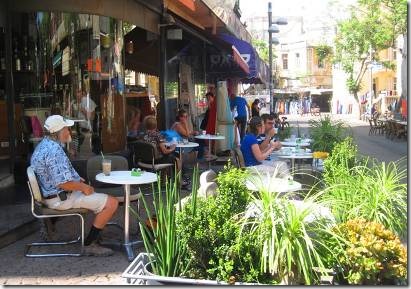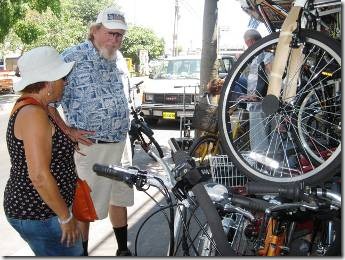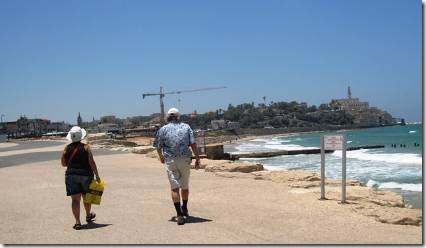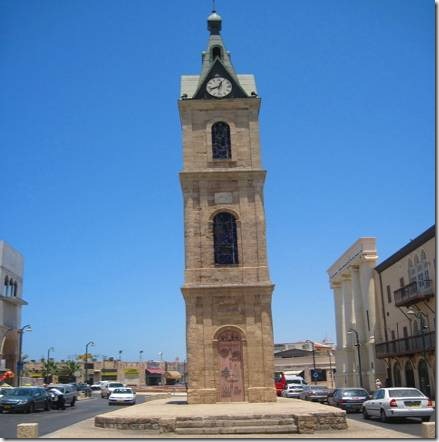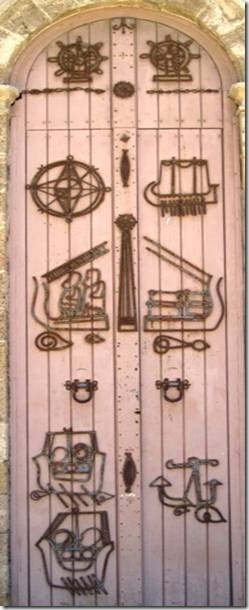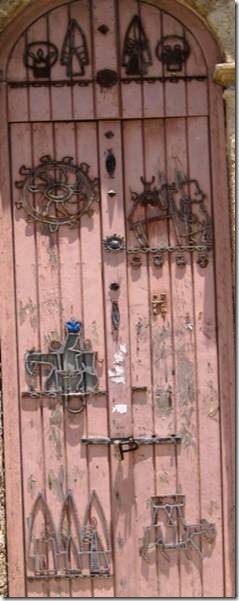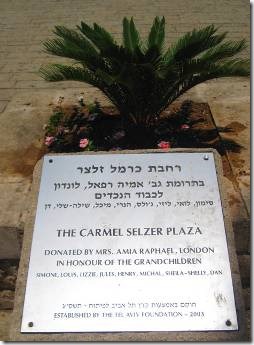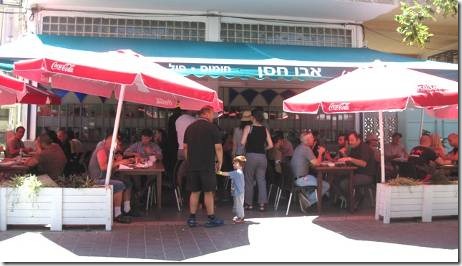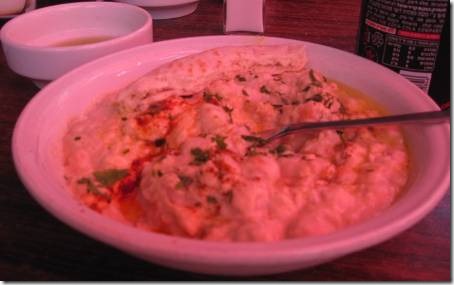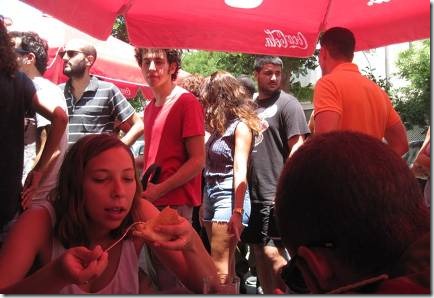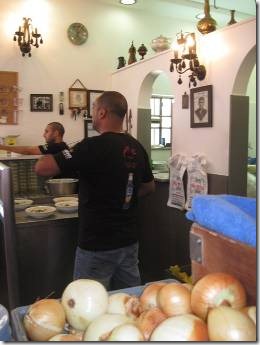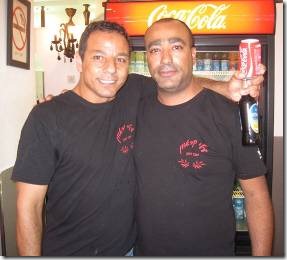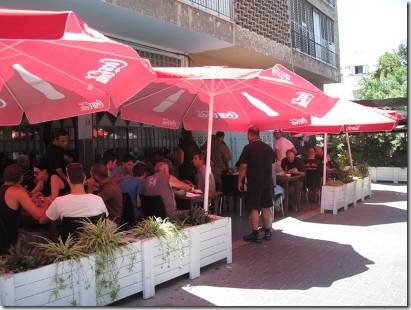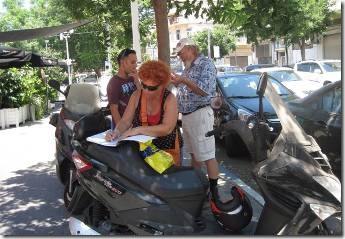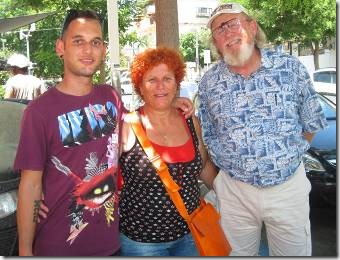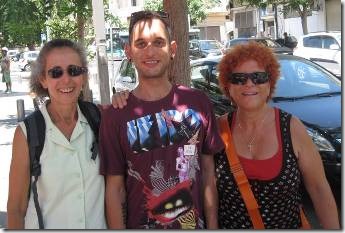Shalom,
It has been a really nice few days so I was in a really good mood when I sat down to finish this email. Then our "neighbors" off across the dock next to Eve’s boat turned on their music loud enough to blast us off the planet…..again. I walked over to ask them to turn it down and they got mad and told me this was how they lived so too bad. They said not to come over every night and tell them to turn it down. Since we’ve been here I’ve asked 3 times, tonight being the 3rd. Other nights, and often during the day, when it isn’t SO LOUD or so POUNDING we just put up with it. Even the Israeli Navy’s music in Herzliya wasn’t so loud. We learned today that we have to move the boat to Ashkelon to check out from Israel so we are thinking to move the boat there for our final few weeks in Israel just to get away from our awful neighbor. It will mean leaving Eve and the little kitty, but for our sanity I think we’ve no choice. And there are things to see in Ashkelon. We’ll see. I actually called Yorman Greenburg, the marina manager this evening because I was so mad. Not sure what he can do. The music is a bit lower and in some ways that’s all they needed to do. Not shut it off, but just not make our windows rattle which is only a slight exaggeration. Now it’s off altogether. Are they cutting off their noses to spite their faces or are they just getting ready to blast off again? Unfortunately they were getting ready to broadcast what sounds like some really bad karaoke. The boat has some really nice music too so if they would play that at a reasonable level we’d probably like it. Even the loud Ramadan Prayers in Indonesia were more tolerable because they had some purpose. These people are insane has become my new overworked phrase since we’ve come to the Ashdod Marina. I use it for the loud music and for the horrible long lines in the grocery stores. Time to leave for sure! Israel is a neat place to visit, but if you’re not fond of blasting music, I would be a bit leery of the marinas.
" Long lines mean good food. When you see a restaurant with a line of people waiting to get in, go there and eat, even if you’re not hungry."
"Don’t ask for the check until you’re finished eating, we’ll have to get up from the table." Both quotes are by Eve’s son Norm and will become clear as you read the email.
Our friend Eve has been working as an evening/overnight care giver just outside of Tel Aviv this past week. So Sunday Randal and I took the 7:48 bus from Ashdod to the Central Bus Station in Tel Aviv and then bus 4 to Shuk Ha Camel to meet her as she has most of the day free. Shuk Ha Camel is a huge bazaar with lots of stalls selling t-shirts, souvenirs, fruit, cheese, wine. We’d been there once before with Linda and Charmaine, but it was on a “market day” and the place was insanely jam packed. Sunday there were no additional market vendors so you could actually walk through the center promenade and not get claustrophobic. We stopped in some of the Judaica shops and I did find a few things.
Because the highways in Israel are just too busy for our small, slow motorbike, Randal and I are becoming veteran bus riders. The HUGE and slightly awful Central Bus Station in Tel Aviv is confusing, but this time we paid attention to where we got off the bus (floor 6 in the back at the Veolia Line.) And we knew we needed to catch the # 4 bus on the Dan Line from the terminal to Shuk Ha Camel to meet Eve. Finding bus 4 was easy; finding the well hidden WC and having the correct 1 shekel change to get in, another story.
We arrived before Eve so found a coffee shop and had a 10 am snack.
Randal ordered his favorite ice coffee smoothie. The cappuccino machine was having an issue so I had to wait for mine. Bad Randal also ate a cheese pastry and I ate part of a honey nut seed thing.
Eve arrived and we walked through the main row of the shuk. Most of the stuff is aimed at tourists, but that’s what I am so I could find a few things that I liked but didn’t cost more than our boat. That’s a slight exaggeration, but you know you’re not in China, India or Malaysia when you go shopping in Israel. We strolled along not taking so much time as we still wanted to walk to Jaffa where we would meet Eve’s son Norm for lunch. (Food plays a big part in this email.)
Emerging from the stalls of the Shuk.
Eve wants a motorized bicycle so we stopped to look.
Graffiti piano at the renovated Train Station complex. (Lots of graffiti in Israel.)
I tried to play but my fingers were stiff from walking and so completely out of practice. Mom was right, I should have practiced. We had stopped mid way between Tel Aviv and Jaffa at the renovated train station to visit the book shop. Eve bought some magazines that her son Norm would take Monday when he left Israel for China to visit his sister who works near Shanghai. I had said that selection was limited as I remembered from our time in China. Eve’s daughter who speaks Hebrew, English, and German is now learning Chinese for her work as a fashion designer. Eve said that there are many Israelis working in the industry in China.
Walking the beach between Tel Aviv and Jaffa
The Clock Tower showing the time in Jaffa.
The clock tower in Jaffa is one of seven clock towers built in Israel and of the hundred clock towers built in the Ottoman Empire in celebration of the 25th anniversary of the reign of the Turkish sultan Abdul Hamid the Second. The towers were built as part of the modern reforms guided by the sultan, in order to conduct the empire’s cities by accurate, Western timetables. According to the local tale, the tower was built at the initiative of Yossef Moial, a wealthy Jew of Jaffa, who erected the clock tower in order to save himself pestering by pedestrians who would come in to his shop to ask the time on their way to the train station.
Four clocks were installed in the tower – two of them showing the time in Europe, and two of them the time in Israel. http://www.oldjaffa.co.il/?CategoryID=212&ArticleID=356
The decorative doors of the clock tower.
I couldn’t really see the stained glass or much of anything else as they were too high and the sun was too bright. I have just spent about an hour trying to find information about the door decorations but no luck other than a tiny bit of info on the following somewhat confusing website.
“The Jaffa clock tower was built in honor of the sultan Abdul Hamid the second in honor of his 25th year in rules, although the initiative for building it actually came from the Jaffa Jewish community. The clock tower concept was Moritz Sheinbergs, a watchmaker, one of the free masons who promoted the establishment of 17 shops on Bostros street. The French company’s management, who won the railway permit in Jaffa in 1892, chose to install by it 7 watches in each train station from Jaffa to Jerusalem. The Jaffa watchtower was reacted with the contribution from the city’s residents, Arabs and Jews. The cornerstone was placed on September 1st 1900. That same morning, both different religions held prayers at the same time, and in the evening the Rishon Le Zion band performed.
The tower stands in the Jaffa main entrance and crossroad- between the new government buildings, the police station, the jailhouse and Muhamdia mosque. In 1901 two stories were built and the third story was in construction. In 1903 the tower was complete, two clocks were installed and in the second floor, Abdul Hamids signature mark was engraved to all four sides of the tower. In 1965 the tower was
renovated by the city of Tel Aviv, new clocks were installed, artistic bars, stained glass windows which illustrate chapters of Jaffas history.
In 2001 the tower was renovated once more with the initiative from the department of tourism in Tel Aviv Jaffa.”
http://www.yourway.co.il/The_Clock_Tower.html
Clock Tower Square in now The Carmel Selzer Plaza
It seems as if almost everything in Israel has some kind of plaque on it. Many are for sad reasons, but this one is in “honor of the 9 grandchildren.”
Ali Karavan (or popularly called Abu Hassan): the best humus in Israel
Eve called her son Norm who met us near Clock Tower Square and led us what felt like half way across Jaffa for lunch. It was hot, we were tired, and it was the best humus I’ve ever eaten. It wasn’t just good humus; it was delicious food. The place was packed with a line out the door when we arrived. I took this photo after we ate.
This is Humus Masabacha
It is served warm, spiced and drizzled with a bit of olive oil. It doesn’t taste like any humus you’ve ever eaten. The smooth part is thick and creamy but there are also bits of chick peas that are still whole, but cooked soft.
Along with the humus you are given a small bowl of lemon/garlic juice, huge chunks of onion and a stack of pita bread. I couldn’t imagine eating the entire dish of humus; it was so huge and who can digest that much chickpea at one time? Having said that, I ate it all and there were no ill after affects. I was brave enough to use some of the lemon/garlic oil but left the onions. Everyone else left the onions too. I wish we’d discovered Abu Hassan’s when Charmaine and Linda were with us. They love humus.
Everyone shares tables and you sit where there’s room. We were next to this young woman and her soldier friend next to me. Those other folks are waiting for us all to hurry up and eat. As soon as our tablemates were finished, two men sat down.
Inside the place was packed too: The man on the left was running the show and serving the food and telling the jokes. Eve asked for the falafel they sometimes serve with the humus and his answer was, “it’s out of season.” There was no time for falafel; it was just too busy for them to do anything than seat people, dish up the humus , plunk down your drinks, and collect the money.
If you are ever in Jaffa….
“Tourists do not tend to explore much past the attractions of the old port, the flea market and a few fish restaurants. The only real exception to the rule is Ali Karavan, popularly known as Abu Hassan’s, which is widely considered the best hummus joint in Israel. Given that Israelis are completely obsessed with hummus, this is saying a great deal. If you want to check out this 40-year-old legendary hole-in-the wall, it’s just down the hill on Dolphin Street. But get there early – by mid-afternoon the hummus is usually all gone, and on Fridays a queue of people starts to gather from early in the morning for their weekend treat.” http://www.cityguidetelaviv.com/new/INDEX/jaffa.htm
http://myjerusalemkitchen.wordpress.com/2012/03/11/hummus-with-mushrooms-onion-and-israeli-%D7%97%D7%95%D7%9E%D7%95%D7%A1/ gives a recipe for this humus dish.
The Ali Karavan restaurant serves the Best Humus in Jaffa, and has been serving it for almost 40 years now. Located in Jaffa, the restaurant was opened by the father of the family, Abu-Hassan, in 1966. Since then it has been known throughout Tel Aviv and Israel for its fresh and creamy humus. You might have to wait quite a while until you manage to get a seat, especially on weekends, but it is worth it. Sitting beside strangers and eating humus with pita-bread and fresh onion. There is nothing quite like it.
The menu is very limited, only humus, Masbacha and pita-bread, topped off with cooked chickpeas or fava beans, and served with fresh onion and lemon juice. Oh, and if you were wondering – There are no napkins. ( I did notice that, but had a package of tissues.)
The ambiance is vibrant and friendly, but you will be expected to be on your way once you have finished eating so others can take your place.
Make sure you arrive for an early lunch (or breakfast), because once the humus is finished the place closes down!
Eve writes a note to put with the magazines she had bought for her daughter while Norm and Randal chat.
Norm, Eve, Randal
Me, Norm and Eve
Norm’s shirt kind of looks like the graffiti painted on the piano. He and I talked a bit about the “street art” that seems to be all over Israel. I really don’t like it much but Norm, being about 30 years younger seems to be able to appreciate it.
We said good-bye to Norm and then Eve, Randal and I walked back to the Jaffa Flea Market but really didn’t have the oomph you need for a place like that. I think we were all too tired and hot (and full) and we were ready to be done. We checked with a taxi to take us all back to Tel Aviv but Eve waved him off saying we weren’t going to pay his “too high tourist prices.” We would take the bus so we walked over to the main road and with Eve’s help got a bus that would take us a block or so from the Central Bus Station. The bus driver assured us he’d tell us where to get off. Unfortunately the driver had already driven several blocks past our stop when he remembered. He’d been having a heated discussion with an elderly lady just after we’d gotten on so apparently forgot about us. When he finally remembered, he pretty much said, “sorry, get off.” So we got off, not at all sure where we were exactly or where the bus terminal was. I wish I could have taken photos but we just wanted to get where we needed to be as fast as we could. South Tel Aviv, in the blocks around the terminal, is not where you want to be if you don’t have to be there. If you have read about the refugee problems in Israel, you have read about the problems in south Tel Aviv. It looks terrible and smells worse. We stopped one women who spoke just enough English to give us vague directions and then I asked the driver of a big yellow minibus who said, “2nd set of lights, go left.” We did and got back to the terminal with no problem; hunted down another hidden WC and managed to catch the #320 bus just about to leave for Ashdod. It had been a really fun day with the special experience of Abu Hassan’s wonderful humus!
Here are some articles about the Tel Aviv Central Bus Station. Picture any large, unappealing bus station you’ve been in and you get the idea.
Tel Aviv Central Bus Station, known as the New Central Bus Station (HaTachana HaMerkazit HaChadasha), is the main bus station of Tel Aviv, Israel. Located in the south of the city, it was opened on August 18, 1993. It was the largest bus station in the world from its opening date until 2010, when it was overtaken by Delhi, India’s Millennium Park Bus Depot. The station covers 230,000 m2 and a total area of 44 dunams (44,000 m2). http://en.wikipedia.org/wiki/Tel_Aviv_Central_Bus_Station
Tel Aviv Central Bus Station.
The entire fourth floor of Tel Aviv’s central bus station shakes every time a bus rumbles along one of the platforms above. In a corner stands a clinic specializing in venereal diseases. Across from the clinic, in one of the “lost spaces” of the cavernous station, an experiment in community restoration has begun: a preschool and daycare center for the children of foreign workers and refugees who live in the area.
“We’re interested in turning the ‘lost spaces’ trapped in the central bus station into spaces that serve the residents of south Tel Aviv. We’re identifying these spaces and adapting the programs the community needs to the spaces’ particular configurations,” says architect Yoav Meiri, the designer of the new preschool and daycare center that recently opened.
“We believe in a slow, informed and thorough process to discover the added value of the central bus station building as part of the social space of the city,” Meiri adds with irrepressible optimism, the kind that allows someone to work instead of sinking into paralyzing inactivity.
With cosmic irony or perhaps poetic justice, the central bus station, which brought destruction to an entire urban neighborhood and its urban and human fabrics, is atoning − albeit very partially − for the wrong it inflicted by providing a home for a humanitarian endeavor, the UNITAF Preschool, Daycare Center and After-school Center Project, founded by the Yehuda Tribitch Memorial Fund for Social Involvement. The effort provides both an immediate solution for preschool children without making the families wait for government decisions, and uncompromising architecture and design that give the lost space a human dimension, a momentary respite, and a humanizing touch. “The greatest and most complex challenge we faced was how to create reasonable conditions under impossible circumstances,” says Ofra Paz, director of the UNITAF Project. Below the school is the commercial bazaar whose photogenic, romantic and multicultural charm does not make up for the station’s original sin.
Meiri sees the proximity of the preschool to the clinic, public transportation and bazaar shops downstairs as “a continuation − or even an enhancement − of the mixed usage motif that characterizes the neighborhood.” More than simple optimism is necessary to be able to view things this way. The preschool inside the door is the light at the end of the tunnel − literally. It is orderly and well-appointed, as well as aesthetically pleasing by any standard. Constraints such as the elongated space and leaky ceiling have been turned into advantages. The rooms are spacious and airy. One of the decisive factors in choosing this lost space was the expansiveness of the windows, originally part of the bus station building itself, letting in copious amounts of natural light. Even the bus ramps viewed through these windows look like a legitimate urban landscape.
The UNITAF Project, which opened its doors in 2005, operates preschools, daycare centers and afternoon programs throughout south Tel Aviv. It serves some 3,000 children, three years old and under, from the community of migrant workers and refugees. In addition to the central bus station location, the project operates preschools in Hatikva and Shapira neighborhoods as well as near the Carmel Market. The central bus station houses two preschools for some 100 children: a long-established infant daycare center slated to be redesigned and refurbished, and the new preschool for children up to age four.
Other project partners are the Tel Aviv Municipality, which leases the spaces for the schools, the municipality’s Mesila aid center for the foreign community, the Tel Aviv Foundation and the Central Bus Station Management Co. Equipment is provided by private donations (which can be made through unitaf@gmail.com). The schools and daycare centers are run by preschool teachers and aides who themselves belong to the foreign community and who previously ran pirate babysitting services, often in surroundings bordering at times on the life-threatening. UNITAF’s contract with the teachers stipulates that they must maintain satisfactory childcare standards, says Paz. The plan and design of the new space are welcoming and supportive. Because the children are there from 7 A.M. until 6:30 P.M., the teachers get extra help from National Service volunteers and others who volunteer there regularly. Some are teaching professionals while others “come with lots of goodwill and the love that the kids need so much,” says Paz.
Nonetheless, she admits that the picture is far from rosy. Some of the children and their parents live under the threat of deportation, and live with a constant sense of impermanence and fear, dead-end violence and conflict.
UNITAF’s next goal is to erect an indoor playground inside the central bus station − an artificial “outdoors” as a stand-in for the real outdoors that is unavailable in the neighborhood, especially for the very young.
The site that has been chosen is a wide spot with tall ceilings that “will be a place for play, creativity, wandering about, and letting off steam for the children at the preschools,” says Meiri, who is also designing the playground for UNITAF. This project is in a sense a mirror image of his previous social/architectural project − the open public library in nearby Levinsky Park.
The designated spot is still a black hole; at a glance, it doesn’t seem ever to have had or be capable of having any sort of human purpose or justification. But judging by the plans and 3D imaging, it will be a brilliantly colorful playground with jungle gyms, a sandbox, wading pools, climbing structures and slides, swimming pools and artificial, neon-green grass − all underneath a ceiling painted in blue “to create the illusion of freedom,” as Meiri puts it.
In light of the recent and ongoing outbreaks of violence directed at the community of migrant workers and refugees in Tel Aviv and at various aid organizations, along with the lack of any official government solutions, a bottomless well of optimism is indeed needed to maintain this vision.
http://www.haaretz.com/news/features/making-tel-aviv-s-central-bus-station-child-friendly-1.429342
http://www.globes.co.il/serveen/globes/docview.asp?did=1000715394&fid=1124 is an article about the building’s history and projected huge revenue losses.

